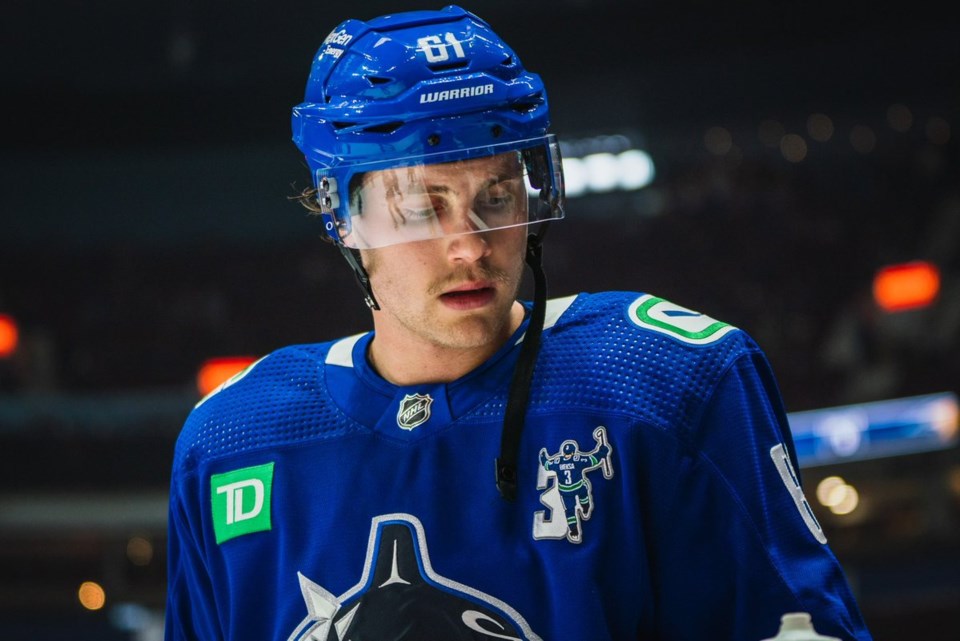Canucks president of hockey operations Jim Rutherford raised some eyebrows with his comments during an interview on Sportsnet 650 when he criticized the team’s structure and preparation at training camp.
It was hard to see it as anything other than a clear shot at the coaching staff headed up by Bruce Boudreau. But while those comments caught the most attention, there was one other concerning element of his interview.
When asked about the possibility of rebuilding, Rutherford said he preferred to use the word “build.” He’s focused on the team adding one piece at a time to become competitive in the future. But the way he talked about building sounded awfully familiar.
“When we bring players in, we’re going to try to bring in relatively young players — 26 years old or younger — and, for the most part, that’s what we’ve done to this point,” said Rutherford. “We’re not trading draft picks for guys in their thirties and things like that. We’re trying to build this together so it can come together — certainly within the next year for next season, if not prior to that.”
If that rings a bell, it’s because it was a similar strategy to Jim Benning when he traded draft picks for young players like Sven Baertschi and Linden Vey, or a younger prospect for an older player. It’s focussing on short-term improvements while trying to sound like it’s aimed at long-term success.
"It's not the cycle we're in to trade high draft picks.”
When Rutherford was hired, he made it clear that he didn’t want to trade away draft picks.
“I want to be careful with our trades,” said Rutherford. “I don't want to trade draft picks, unless they're later-round picks. It's not the cycle we're in to trade high draft picks.”
And yet, to clear cap space — space that needed to be cleared because they made no moves to clear cap space in the offseason, spent to the cap in free agency, and didn’t trade J.T. Miller — Rutherford and general manager Patrik Allvin traded away a second-round pick with Jason Dickinson for 24-year-old defenceman Riley Stillman.
Then the Canucks traded two prospects, Jonathan Myrenberg and Michael DiPietro, for 23-year-old Jack Studnicka. To be fair, DiPietro had requested a trade, but Myrenberg was the Canucks' top defensive prospect on the right side.
If the defence for these trades is that Stillman and Studnicka are under 26, that’s not particularly comforting. It’s pretty clear already who Stillman and Studnicka are at the NHL level and neither are particularly good. Perhaps they can hold down an NHL roster spot but in acquiring them the Canucks gave up a pick and a prospect that could potentially have had a greater impact in the future.
Maybe Jonathan Myrenberg won’t become a legitimate top-four defenceman like Gustav Forsling, who Benning traded away for 17 games of Adam Clendening. Maybe that second-round pick won’t become a top-pairing defenceman like Rasmus Andersson, who was drafted with the second-round pick the Canucks traded for Baertschi.
But those are two immediate examples of the type of top-four defencemen the Canucks could desperately use right now who are not on the team’s current roster because the previous management acquired “relatively young players” to make quick improvements. What impact players will the future Canucks not have on their roster because of decisions made by the current management?
It's that philosophy of short-cutting their way past the development stage that led to what Jason Botchford called "The Sea of Granlunds" — a wealth of mediocre players but no truly impactful players.
"It's not necessarily a total teardown and rebuild."
The fact is that the Canucks’ roster is fundamentally flawed because it was never built with any overriding direction. Every offseason over the past eight years, the Canucks made moves with one goal in mind — make the playoffs the next season and damn the long-term consequences. The end result is the current Canucks.
The response from Rutherford and Allvin has been to double down on the flawed roster and trade away draft picks and prospects to try to place bandaids over gaping wounds.
Furthermore, when talking about potential future trades, Rutherford suggested that they wouldn’t make any deals that involved taking even a temporary step back.
“Maybe we’re going to get to a point where we’re gonna have to take a look at trading one or two players that, in the offseason, we would never consider doing,” said Rutherford. “Now, the only way we would do that is to trade that player and get something in return that we can at least stay the same as we are now and get a couple more younger assets.
“That’s what I talk about when we build — it’s not necessarily a total teardown and rebuild, we just keep building piece by piece by piece.”
It sounds like the Canucks management is seeking the unicorn of trades: the trade that simultaneously makes the team no worse in the present but somehow also adds picks and prospects for the future. If this mythical trade requires the Canucks to “stay the same” wouldn’t the opposing team also “stay the same?”
What team is going to willingly be a partner for this trade that would require them to give the Canucks prospects for a player who theoretically, doesn’t improve their team?
If this is the type of trade the Canucks were seeking for Miller, it’s no wonder they never found a trade partner. If the Canucks aren’t willing to get even a little bit worse in the present in order to build a better team for the future, then they’re completely hopeless.




